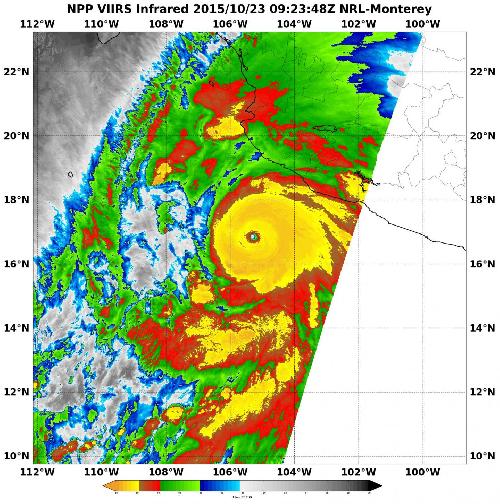At 8 a.m. EDT on October 23, 2015, the National Hurricane Center said that Hurricane Patricia had grown into a monster hurricane. In fact, it is the strongest eastern north pacific hurricane on record. NASA-NOAA's Suomi NPP satellite analyzed the temperatures and structure within the storm as it passed overhead.
On October 23, a Hurricane Warning was in effect from San Blas to Punta San Telmo. A Hurricane Watch was in effect from east of Punta San Telmo to Lazaro Cardenas and a Tropical Storm Warning was in effect from east of Punta San Telmo to Lazaro Cardenas.
When NASA-NOAA's Suomi NPP satellite passed over Patricia on October 23 at 0923 UTC (5:23 a.m. EDT) the Visible Infrared Imaging Radiometer Suite or VIIRS instrument that flies aboard Suomi NPP looked at the storm in infrared light. Cloud top temperatures of thunderstorms around the eyewall were near minus 90 Celsius (minus 130 Fahrenheit). Recent microwave imagery shows hints of a concentric eyewall developing. If the trend toward an eyewall replacement continues, it would cause the intensity to at least level off later today.

Two Records Broken
The National Hurricane Center reported that Patricia is the strongest hurricane on record in the National Hurricane Center's area of responsibility (AOR) which includes the Atlantic and the eastern North Pacific basins. The minimum central pressure estimated from the aircraft data, 880 millibars, is the lowest ever for our AOR. The National Hurricane Center noted "It seems incredible that even more strengthening could occur before landfall later today. The official forecast shows only a little more strengthening before landfall."
Latest Statistics and Location
At 8 a.m. EDT (1200 UTC) on Oct. 23, the eye of Hurricane Patricia was located near latitude 17.3 North, longitude 105.6 West. That's about 145 miles (235 km) southwest of Manzanillo, Mexico and about 215 miles (345 km) south of Cabo Corrientes, Mexico.
Patricia was moving toward the north-northwest near 12 mph (19 kph) and a turn toward the north is expected later this morning, followed by a turn toward the north-northeast this afternoon. On the forecast track, the core of Patricia will make landfall in the hurricane warning area today, October 23, 2015 during the afternoon or evening.
Maximum sustained winds remain near 200 mph (325 kph) with higher gusts. The National Hurricane Center (NHC) said that Patricia is a category 5 hurricane on the Saffir-Simpson Hurricane Wind Scale. Some fluctuations in intensity are possible today, but Patricia is expected to remain an extremely dangerous category 5 hurricane through landfall. Hurricane force winds extend outward up to 30 miles (45 km) from the center and tropical storm force winds extend outward up to 175 miles (280 km). The estimated minimum central pressure is 880 millibars.
Winds, Rainfall, Storm Surge
NHC said that Hurricane conditions are expected to first reach the hurricane warning area this afternoon. Tropical storm conditions are beginning to spread across portions of the warning area. Patricia is expected to produce total rainfall accumulations of 8 to 12 inches, with isolated maximum amounts of 20 inches, over the Mexican states of Nayarit, Jalisco, Colima, Michoacan and Guerrero through Saturday. These rains could produce life-threatening flash floods and mud slides. An extremely dangerous storm surge is expected to produce significant coastal flooding near and to the right of where the center makes landfall. Near the coast, the surge will be accompanied by large and destructive waves.
Swells generated by Patricia are already affecting portions of the southern coast of Mexico, and will spread northwestward during the next day or so. These swells are likely to cause life-threatening surf and rip current conditions.
NHC forecasters said that Patricia is heading for potentially catastrophic landfall in southwestern Mexico later today. NHC Forecaster Pasch said "in addition to the coastal impacts, very heavy rainfall is likely to cause life-threatening flash floods and mud slides in the Mexican states of Jalisco, Colima, Michoacan and Guerrero continuing into Saturday.
Given the very mountainous terrain that Patricia should encounter after landfall, the cyclone should weaken even faster over land than predicted by the normal inland decay rate."





Comments